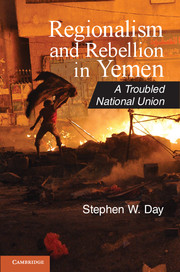Book contents
- Frontmatter
- Contents
- Tables
- Maps and Photos
- Preface
- Acknowledgments
- Abbreviations
- Chronology of Modern Yemeni History
- Glossary of Names of Key Political Figures
- Introduction
- 1 Understanding the Regional Divisions of Yemen
- 2 Two Revolutions, Two Republics
- 3 Salih Family Rules and the Sanhan Tribe
- 4 Unity in Name Only
- 5 The Spoils of Civil War
- 6 A Regime in Control?
- 7 Political Eruptions after 9/11
- 8 The Return of Yemeni Regionalism
- 9 Yemen’s Political Meltdown
- Conclusion
- Appendix
- Bibliography
- Index
- References
7 - Political Eruptions after 9/11
Published online by Cambridge University Press: 05 July 2012
- Frontmatter
- Contents
- Tables
- Maps and Photos
- Preface
- Acknowledgments
- Abbreviations
- Chronology of Modern Yemeni History
- Glossary of Names of Key Political Figures
- Introduction
- 1 Understanding the Regional Divisions of Yemen
- 2 Two Revolutions, Two Republics
- 3 Salih Family Rules and the Sanhan Tribe
- 4 Unity in Name Only
- 5 The Spoils of Civil War
- 6 A Regime in Control?
- 7 Political Eruptions after 9/11
- 8 The Return of Yemeni Regionalism
- 9 Yemen’s Political Meltdown
- Conclusion
- Appendix
- Bibliography
- Index
- References
Summary
On October 12, 2000, the USS Cole pulled into Aden harbor to receive fuel on its way to the Persian Gulf, where it planned to join an ongoing operation enforcing decade-long economic sanctions against Iraq. A few boats from Aden’s port authority helped the enormous American naval destroyer position itself along the fuel depot. Minutes later, as the USS Cole was tied to its moorings, two men in a small white watercraft, approximately twenty-five feet long, motored slowly toward the American ship. Sailors stood at ease along the USS Cole’s deck. The two men aboard the skiff drew close to the ship’s port side, waving at the sailors who stood high above them. The sailors waved back, and then there was a massive blast that completely destroyed the skiff and nearly sank the American destroyer.
It was later determined that this October 2000 blast came from a bomb estimated to weigh five hundred pounds. The bomb consisted of powerful C-4 plastic explosive material prepared by agents of al-Qaeda who shaped it around a projectile that was positioned in the bow of the skiff to cause maximum damage at the USS Cole’s waterline. The thick steel hull of the Cole was designed to withstand more than fifty thousand pounds of pressure per square inch. The exploding bomb ripped through this steel, creating a jagged hole forty feet wide and twenty feet high. The force of the blast thrust the ship’s lower decks upward, crushing a group of sailors who were eating lunch inside an onboard dining hall. Seventeen American sailors died, and nearly forty others were injured. When seawater began pouring into the gaping blast hole, the billion dollar destroyer listed slightly to its side. But it did not sink.
- Type
- Chapter
- Information
- Regionalism and Rebellion in YemenA Troubled National Union, pp. 195 - 225Publisher: Cambridge University PressPrint publication year: 2012



